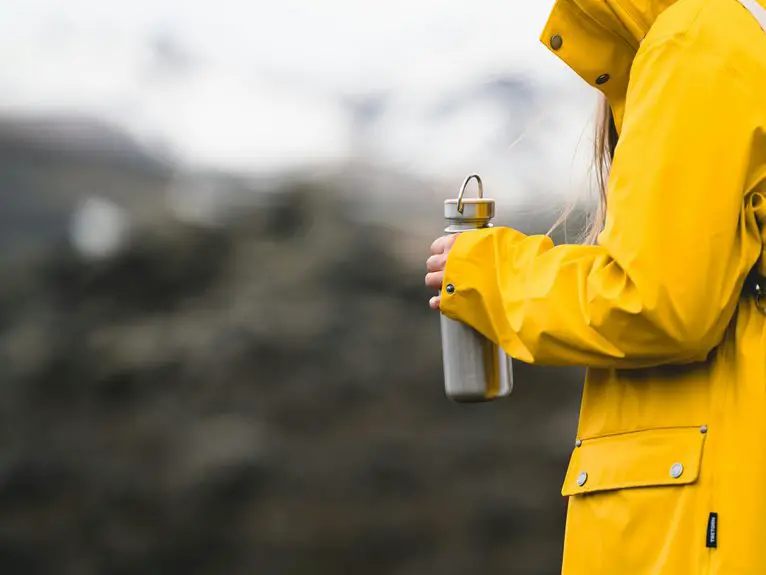Your Gore-Tex jacket isn’t waterproof anymore likely because the Durable Water Repellent (DWR) coating has worn off, and dirt or oils have clogged its breathable membrane. This stops water from beading up and causes moisture to soak in, reducing its effectiveness. Everyday wear, exposure to elements, and lack of maintenance all play a role. With the right cleaning and reproofing steps, you can restore its performance and keep it protecting you longer—there’s more to know about how to do this properly.
Table of Contents
Key Takeaways
- The Durable Water Repellent (DWR) coating may have worn off, causing water to soak instead of bead on the jacket’s surface.
- Dirt, oils, and contaminants can clog Gore-Tex membrane pores, reducing breathability and waterproof effectiveness.
- Frequent use without proper cleaning degrades the DWR coating and allows moisture to penetrate the fabric.
- Signs like wet spots inside the jacket or a soggy feel indicate membrane or outer fabric waterproof failure.
- Lack of maintenance, such as not reapplying DWR treatment or washing improperly, diminishes waterproof performance over time.
Understanding How Gore-Tex Technology Works
Gore-Tex technology relies on a unique membrane that keeps water out while letting sweat escape. When you wear a Gore-Tex jacket, that membrane acts as a barrier, blocking rain and snow from soaking through. At the same time, it allows moisture from your body—like sweat—to evaporate, keeping you dry and comfortable.
You might wonder how this happens. The membrane contains microscopic pores, smaller than a water droplet but larger than a water vapor molecule. This size difference means liquid water can’t pass through, but vapor can.
The Role of Durable Water Repellent (DWR) Coating
You rely on the Durable Water Repellent (DWR) coating to keep water from soaking into your Gore-Tex jacket’s outer fabric.
Over time, this coating wears off, reducing its effectiveness and causing wet spots.
To maintain your jacket’s waterproof performance, you’ll need to reapply the DWR treatment regularly.
Purpose of DWR Coating
A Durable Water Repellent (DWR) coating plays a fundamental role in keeping your jacket waterproof by causing water to bead up and roll off the fabric’s surface.
Without this coating, water would soak into the outer fabric, making your jacket heavy and less breathable. The DWR helps maintain the jacket’s breathability by preventing water from clogging the pores of the Gore-Tex membrane underneath.
This means you stay dry not only from rain but also from your own sweat. Primarily, the DWR acts as the first line of defense against moisture, ensuring water doesn’t penetrate the outer layer.
When it’s working well, your jacket repels water efficiently, keeping you comfortable and dry during outdoor activities.
DWR Wear and Tear
Many factors contribute to the gradual breakdown of the DWR coating on your jacket, including exposure to dirt, oils, and repeated washing.
Over time, these elements wear down the microscopic layer that causes water to bead up and roll off the fabric. When the DWR wears off, water starts soaking into the outer material instead of sliding away, which makes your jacket feel less waterproof.
Even everyday use can degrade the coating, especially when you brush against rough surfaces or carry heavy backpacks.
While Gore-Tex membranes remain waterproof, the loss of the DWR layer greatly reduces overall water resistance.
Understanding this wear and tear helps you recognize why your jacket might feel damp during wet conditions despite being Gore-Tex.
Reapplying DWR Treatment
Although the Gore-Tex membrane keeps water from penetrating, the jacket won’t stay truly waterproof without a functioning DWR coating.
Over time, dirt, oils, and wear break down this outer layer, causing water to soak in instead of bead up. To restore your jacket’s water repellency, you need to reapply DWR treatment regularly.
Start by cleaning your jacket thoroughly, using a gentle, technical fabric cleaner to remove residues that block the DWR’s effectiveness.
Once dry, apply a spray-on or wash-in DWR product following the manufacturer’s instructions. Heat activation through tumble drying or ironing (if allowed) helps the treatment bond properly.
Reapplying DWR not only revives water beading but also keeps your Gore-Tex jacket performing at its best in wet conditions.
Effects of Dirt and Oils on Waterproof Performance
You mightn’t realize how much dirt and oils can harm your Gore-Tex jacket’s waterproof abilities.
Oils break down the fabric’s protective layers, while dirt blocks water from beading off like it should.
Understanding these effects helps you keep your jacket performing at its best.
Impact of Surface Contaminants
When dirt and oils accumulate on your Gore-Tex jacket, they can clog its microscopic pores and reduce its ability to repel water.
These surface contaminants create a barrier that prevents moisture from beading up and rolling off as it should. As a result, water soaks into the fabric instead of staying on the surface. You might notice your jacket feels heavier and damp inside during rain.
Everyday activities like hiking through dusty trails or touching your jacket with oily hands contribute to this buildup. Even pollutants from the environment can stick to the fabric over time.
To maintain your jacket’s waterproof performance, it’s essential to clean off dirt and oils regularly. Ignoring this can lead to decreased breathability and comfort on your outdoor adventures.
How Oils Degrade Fabric
Oils don’t just sit on the surface of your Gore-Tex jacket—they actively break down the fabric’s waterproof capabilities.
When oils from your skin, food, or environmental sources come into contact with the jacket, they clog the microscopic pores designed to repel water but allow breathability. This buildup reduces the jacket’s ability to wick moisture and causes water to bead up or soak through.
Additionally, oils can weaken the durable water repellent (DWR) coating, which is essential for shedding rain and snow. If you don’t clean your jacket regularly, these oils accumulate, making it harder for water to slide off.
To keep your Gore-Tex effective, you need to remove oils promptly using appropriate cleaners that won’t damage the fabric or its waterproof membrane.
Dirt’s Role in Water Resistance
Although dirt might seem harmless, it plays a significant role in reducing your Gore-Tex jacket’s water resistance.
When dirt accumulates on the fabric’s surface, it clogs the tiny pores that let moisture escape while blocking water from getting in. This buildup creates a barrier that prevents breathability and causes water to bead up or soak through.
Besides dirt, oils from your skin or environment also attract grime, worsening the problem. If you don’t clean your jacket regularly, these contaminants can degrade the durable water repellent (DWR) coating, which is essential for maintaining waterproof performance.
To keep your Gore-Tex jacket working properly, you need to wash it gently but thoroughly and reapply a DWR treatment when needed.
Dirt and oils aren’t just messy—they actively impair your jacket’s effectiveness.
Signs Your Jacket’s Waterproofing Is Failing
How can you tell if your Gore-Tex jacket’s waterproofing is starting to fail? One clear sign is when water starts soaking through instead of beading up on the surface.
Water soaking through instead of beading up signals your Gore-Tex jacket’s waterproofing is failing.
If you notice wet spots or damp patches inside after light rain, your jacket’s protective layer isn’t doing its job.
Another indicator is when the fabric feels heavier or soggy after exposure to moisture. You might also see water pooling on the surface instead of rolling off quickly.
Additionally, if the jacket’s outer material loses its smooth, slightly shiny appearance and looks dull or worn, the waterproof coating may be compromised.
Finally, if your jacket feels less breathable and traps moisture inside, its waterproof membrane might be degrading, signaling it’s time for restoration or replacement.
How Regular Use and Wear Impact Waterproofing
When you wear your Gore-Tex jacket regularly, the constant friction, exposure to dirt, and repeated washing gradually wear down its waterproof coating.
Everyday activities like backpack straps rubbing against the fabric or brushing against rough surfaces cause tiny abrasions that weaken the durable water-repellent (DWR) finish.
Dirt and oils from your skin build up on the surface, clogging pores and preventing water from beading and rolling off as it should.
Over time, washing your jacket too often or with harsh detergents strips away essential treatments, reducing its effectiveness.
Even though Gore-Tex membranes remain waterproof at their core, the outer layers need proper care to maintain full protection.
Understanding how use affects your jacket helps you notice when it’s time for attention before leaks appear.
Steps to Restore Waterproofing on Your Gore-Tex Jacket
If your Gore-Tex jacket starts to lose its water resistance, you can take straightforward steps to restore its waterproofing.
First, wash your jacket using a gentle, technical wash designed for waterproof gear—avoid regular detergents as they can strip the DWR (Durable Water Repellent) coating.
After washing, tumble dry your jacket on a low heat setting or use a warm iron with a cloth between the iron and fabric to reactivate the DWR treatment.
If the water still beads poorly, apply a spray-on or wash-in DWR treatment, following the product instructions carefully.
These steps help renew the jacket’s ability to repel water and keep you dry.
Restoring waterproofing regularly extends your jacket’s lifespan and performance in wet conditions.
Preventative Care to Maintain Long-Term Waterproofing
Restoring your Gore-Tex jacket’s waterproofing is important, but maintaining that protection over time saves you from frequent repairs.
Restoring your Gore-Tex jacket’s waterproofing is key, but ongoing maintenance prevents frequent repairs.
To keep your jacket performing at its best, you need to adopt simple yet consistent care habits. Here’s what you should do:
- Clean your jacket regularly with a gentle, technical wash to remove dirt and oils.
- Reapply a durable water repellent (DWR) treatment as soon as you notice water no longer beads on the surface.
- Avoid harsh detergents or fabric softeners, which can damage the membrane.
- Store your jacket in a cool, dry place away from direct sunlight to prevent material breakdown.
Frequently Asked Questions
Can Gore-Tex Jackets Be Machine Washed Without Damaging Them?
You can machine wash Gore-Tex jackets, but use cold water and a gentle cycle. Avoid fabric softeners and bleach. After washing, tumble dry on low or use an iron to reactivate the durable water repellent coating.
How Long Does a Gore-Tex Jacket Typically Last?
You can expect your Gore-Tex jacket to last around 5 to 10 years with proper care. Regular washing and reproofing help maintain its performance, so you’ll stay dry and comfortable during all your adventures.
Are All Gore-Tex Jackets Equally Breathable?
Sure, all Gore-Tex jackets are equally breathable—if you love feeling like a sauna. In reality, breathability varies by model and fabric weight, so you’ll want to pick one matching your activity and climate needs.
Can I Use Any Waterproof Spray on My Gore-Tex Jacket?
You shouldn’t use just any waterproof spray on your Gore-Tex jacket. Choose sprays specifically designed for Gore-Tex fabrics to maintain breathability and waterproofing. Using the wrong spray can damage the membrane and reduce performance.
Does Gore-Tex Technology Work in Extreme Cold Weather?
Gore-Tex works well in extreme cold because it’s breathable and waterproof, but you’ll want to layer properly. It won’t keep you warm alone, so pair it with insulating layers to stay comfortable in freezing conditions.
- The Use of Nonwovens in Construction and Civil Engineering - July 11, 2025
- The Use of Nonwovens in Construction and Civil Engineering - July 11, 2025
- The Use of Nonwovens in Construction and Civil Engineering - July 11, 2025







